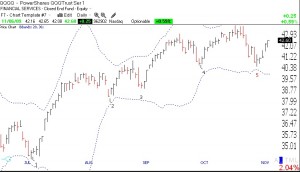Up-trend continues with my indicators at their maximum values. I am away and cannot write a full post.
 Dr. Wish
Dr. Wish
Market up-trend back on track after bouncing off of Bollinger band; Gold shines, STEC falters.
Well, the indexes again bounced off of their lower Bollinger bands and the market’s short term up-trend resumed. Note the 5th bounce that I just added in red to the chart I posted on 10/19 after four bounces.  Review that post if you want to understand the logic of Bollinger bands. If only I had the patience to wait for the bounce to enter my long positions! Maybe next time. The QQQQ is even back above its 10 week average! So, as much as I hate being whipsawed by the recent decline, if I flew solely by instrument, I would have to be long again. But watch out for a possible right shoulder forming in a head and shoulder pattern. If the QQQQ falters before it surpasses the peak reached on 10/21, we could see a large drop, especially if QQQQ closes below the neckline, around 40.6 . So, if I go long, I will place some close sell stops and monitor QQQQ’s progress very carefully. Meanwhile, the GMI is
Review that post if you want to understand the logic of Bollinger bands. If only I had the patience to wait for the bounce to enter my long positions! Maybe next time. The QQQQ is even back above its 10 week average! So, as much as I hate being whipsawed by the recent decline, if I flew solely by instrument, I would have to be long again. But watch out for a possible right shoulder forming in a head and shoulder pattern. If the QQQQ falters before it surpasses the peak reached on 10/21, we could see a large drop, especially if QQQQ closes below the neckline, around 40.6 . So, if I go long, I will place some close sell stops and monitor QQQQ’s progress very carefully. Meanwhile, the GMI is
GMI down to 2; Getting defensive
The market deteriorated very quickly last week. The 4 down days occurred on much higher volume than the single up day. In fact, the up volume of some of the bear 3X ETF’s (EDZ, FAZ, ERY) was the highest I have ever seen, especially on Friday. The 2X Ultra short QQQQ ETF (QID) also had huge up volume. This suggests that the pros are making huge bets on the short side. The Worden T2108 is now at 21%, not yet at extreme oversold levels, but it is getting there. The GMI fell